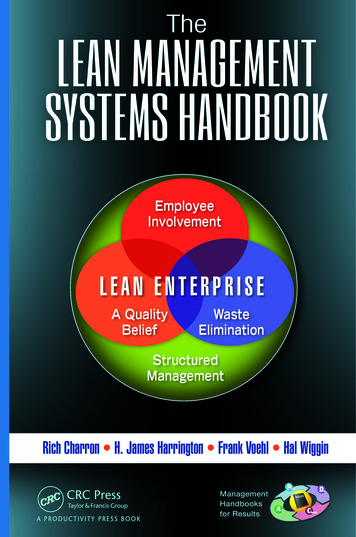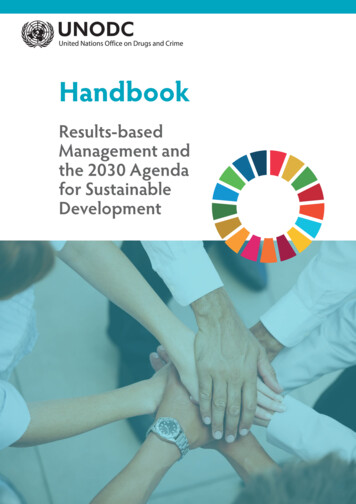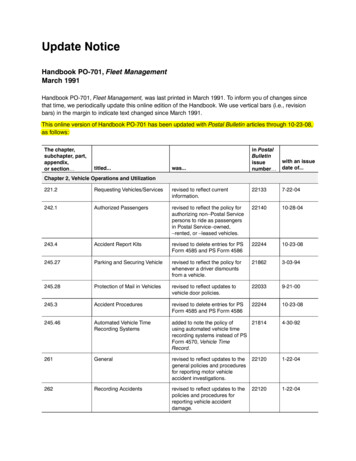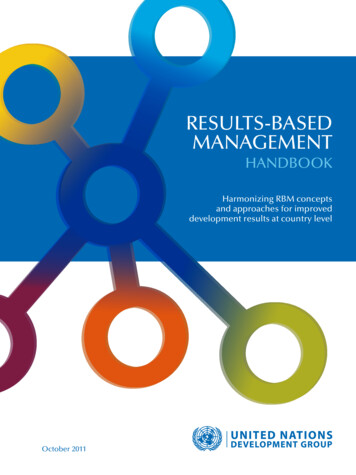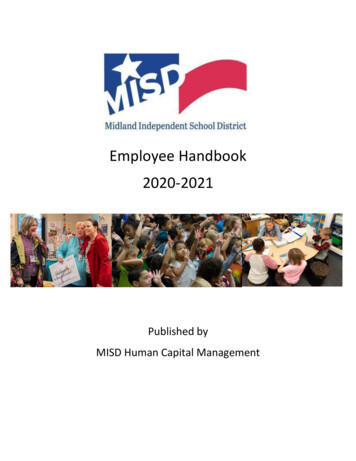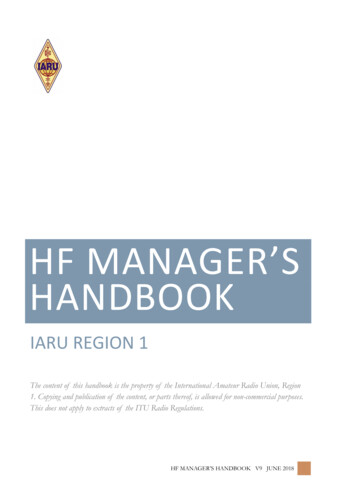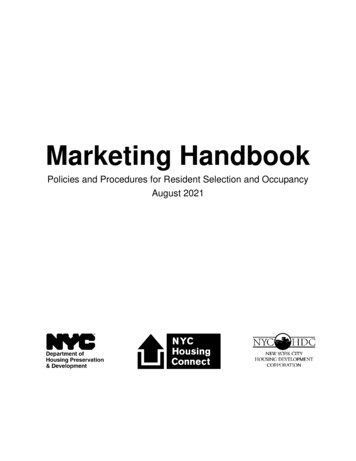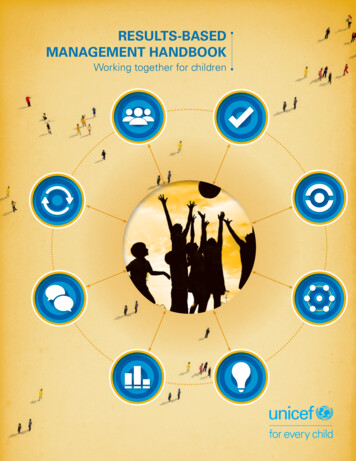
Transcription
RESULTS-BASEDMANAGEMENT HANDBOOKWorking together for childrena
AcknowledgementsThe development of the Results-Based Management Handbook: Working together for childrenwas an organization-wide effort led by UNICEF’s Field Results Group, in collaboration with theDivision of Data, Research and Policy, the Office of Emergency Programmes and the ProgrammeDivision. Omar Abdi, Stephen Adkisson and Etona Ekole initiated and coordinated the preparation of the handbook. The following staff members and consultants were instrumental inits development and production either through workshops or through direct inputs to thecoordination team:ConsultantsMarcio Carvalho (independent consultant)Françoise Coupal (Mosaic.net International Inc.)Natalie Zend (ZENDialogue Consulting Services)ContributorsCountry office staff: Shandana Aurangzeb, Rajae Msefer Berrada, Nelisiwe Dlamani, MohamedEl Bechir, Patrizia di Giovanni, Ananya Goswami, Clemens Gros, Anoop Singh Gurung,Shaheen Hussain, Katarina Johansson, Peter Leth, Paolo Mefalopulos, Antero Pina, Anna Riatti,Juan Santander, Nafisa Binte Shafique, Serge ZangaRegional office staff: Isa Achoba, Christine Muhigana, Hervé Périès, Ndeye Djigal Sall,Inoussa Kabore, Paola Babos, Melva Johnson, Riccardo Polastro, Bertin Gbayoro, EdwardAddai, Abheet Solomon, Geetanjali Narayan, Roumiana Gantcheva, Uzma Aftab, Fabio Sabatini,Lori Bell, Sabina Zunic, Maha Muna, Aida Oliver, Bastiaan van‘t HoffHeadquarters staff: George Laryea-Adjei, Cairan O’Toole, Maniza Zaman, Gabriele Fontana,Pia Britto, Mathieu Brossard, Gabrielle Bonnet, Daniel Kelly, Anju Malhotra, Noreen Khan,Nora Fyles, Laila Irani, Jennifer Keane, Mary Louise Eagleton, Juliette Haenni, David Anthony,Waithira Gikonyo, Ian Thorpe, Yasmin Jamshed, Hamish Young, John Lewis, Bilal Aurang ZebDurrani, Larissa Bruun, Gian Gandhi, Regine Weber, Atieno Ojoo, AbdulKadir Musse, FrancescaLombardi, Gurpreet Singh Samrow, Tanya Belcheva, Fernando Gutierrez-Eddy, Deguene Fall.ReviewersKate Alley, Anna Boelens, Silvia Chiarucci, Christopher Davids (consultant), Etona Ekole,Wesley Furrow, Boniface Kalanda, Haleem Lone, Ada Ocampo, Roger Pearson, Ray Rist(consultant), Sarah Schouwenaar, Andrea Suley, Timothy Takona, Raquel Wexler.EditorLois Jensen, The Write Way, Inc.DesignGreen Communication Design, Inc. www.greencom.caResults-Based Management Handbook: Working together for Children United Nations Children’s Fund (UNICEF), 2017Any part of this publication may be freely reproduced, if appropriate acknowledgementis provided.
RESULTS-BASEDMANAGEMENT HANDBOOKWorking together for children
ii Results-based Management Handbook : Working together for children
iiiCONTENTSForeword ixAbbreviations and acronyms 1Introduction 2Background 2Purpose 3Intended audience 4Structure 4Chapter 1. Results-based management in a nutshell What is results-based management? 56What are the principles of results-based management? 12Why does UNICEF use results-based management? 14Does results-based management apply to me? 17What are common pitfalls in applying results-based management? 19Chapter 2. Planning for results 21Background 22Guidelines for results-based strategic planning 22Key steps in strategically planning for results 24Step 1. Understand the situation 24Tool A: Causality analysis Tool B: Monitoring results for equity –A 10 determinant framework Step 2. Prioritize issues for action Tool C: The prioritization funnel with five filters Step 3. Devise a theory of change Tool D: Theory of change 262930313237Step 4. Define desired results 38Step 5. Align results, strategies and funding 50Step 6. Assess assumptions and risks 54Tool E: Risk monitoring and response matrix 59
iv Manual sobre la gestión basada en resultados: la labor conjunta en favor de la niñezStep 7. Draw it all together in a results framework and theory ofchange narrative 60Tool F: Results framework Step 8. Develop a monitoring plan Tool G: Monitoring plan Step 9. Assess the evaluability of the programme Chapter 3. Implementation 6065657475Overview 76Key steps in implementation 78Step 1. Plan for implementation 79Tool H: A sample work plan template Step 2. Manage implementation & monitoring 8992Step 3. Make adjustments & take corrective action 100Ongoing steps 101Tool E: Risk monitoring and response matrix (Chapter 2) Chapter 4. Monitoring for results 59105Overview 106Key steps in monitoring for results 108Step 1. Consult your results framework 109Tool G: Monitoring plan (Chapter 2) 65Step 2. Plan for monitoring 109Step 3. Select monitoring tools and approaches 116Step 4. Collect and analyse data 119Step 5. Communicate and report findings 123Step 6. Take corrective action 124Chapter 5. Evaluating results 126Overview 127Key steps in managing an evaluation 132Step 1. Assess utility, necessity, evaluability 133Step 2. Plan and commission the evaluation 136
vStep 3. Manage the inception phase 138Step 4. Provide ongoing support, including informationcollection and analysis 140Step 5. Disseminate and use evaluation findings 142Step 6. Prepare and track the implementationof the management response 142Step 7. Use evaluation for learning 145Chapter 6. Reporting results 146Overview 147Key steps in reporting results 151Step 1. Understand the information needs of your audience 152Step 2. Prepare your results-based reporting format 152Step 3. Refer to your results framework and monitoring plan 154Step 4. Collect the data 154Step 5. Be visual: Use charts, graphs, photos, testimonials 155Step 6. Tell your performance story, movingfrom activities to results 156Step 7. Manage the reporting function 161Step 8. Learn, adjust and adapt 162Conclusion 164Glossary 165Endnotes 175FiguresFigure 1.1.Results-based management: A snapshot 7Figure 1.2.The results-based management programme cycle 9Figure 1.3. Applying results-based management:Planning for, achieving and demonstrating results 11Figure 1.4. RBM: An organizational approach that creates synergyamong management processes, tools and staff skills 12Figure 2.1.Nine steps in strategically planning for results 24
vi Manual sobre la gestión basada en resultados: la labor conjunta en favor de la niñezFigure 2.2.Levels of causes 25Figure 2.3.Tool A: Causality analysis 26Figure 2.4.Tool C: The prioritization funnel with five filters 31Figure 2.5.Tool D: Theory of change 37Figure 2.6.Key principles of results-based planning 40Figure 2.7. Building a results chain using the‘if-then’ logic of the theory of change 41Figure 2.8.One example of a results chain 42Figure 2.9.Another example of a results chain 43Figure 2.10. Formulating a results statementthat begins with a change verb 45Figure 2.11. Formulating a results statement using a presenttense verb to indicate a desired future 46Figure 2.12.Formulating a results statement 46Figure 2.13.SMART criteria 47Figure 2.14.Checklist for formulating results 48Figure 2.15.Aligning the budget with a strategy to deliver outputs 51Figure 2.16. Devising a strategy and outputs: An iterative processinfluenced by funding 52Figure 2.17.Types of costs to consider when budgeting 52Figure 2.18.Ensuring value for money in the programme cycle 53Figure 2.19.Examples of risk types and categories 57Figure 2.20.A sample theory of change narrative 62Figure 2.21.Examples of data collection methods 71Figure 3.1.Key steps in results-based implementation 79Figure 3.2. A Gantt chart showing sequencing and timingof programme activities 87Figure 3.3.A sample programme activity diagram 88Figure 3.4.Tool H: A sample work plan template 89Figure 3.5.Levels of monitoring 98Figure 3.6.Connecting risk response with costs and results Figure 3.7. Using performance information fororganizational learning 102104
viiFigure 4.1.Types of monitoring 107Figure 4.2.Six steps in results-based management monitoring 108Figure 5.1.Results: A product of many contributing factors 132Figure 5.2. Seven steps in a results-based managementevaluation process 133Figure 5.3.High and low evaluability 134Figure 6.1.Eight steps in reporting results 151Figure 6.2. Example of how data can be translatedinto a visual format 156Table 2.1. Tool B: Monitoring results for equity –A 10 determinant framework 29Table 2.2.The results chain: Definitions and examples 39Table 2.3.Objectives versus results 44Table 2.4.Examples of results statements 49Table 2.5.Examples of assumptions and how to deal with them 55Table 2.6.Risk-level matrix 57Table 2.7.Tool E: Risk monitoring and response matrix 59Table 2.8.Tool F: Results framework 60Table 2.9. xample of a partial results frameworkEfor one country programme component 61Table 2.10.A sample theory of change in graphic form 63Table 2.11.Tool G: Monitoring plan 65Table 2.12.Quantitative and qualitative indicators 66Table 2.13.Possible disaggregation of one indicator 67Table 2.14.Checklist for indicator selection and validation 68TablesTable 2.15. Examples of indicators and related baselinesand targets 70Table 2.16.Example of a completed measurement framework forTable 2.17. Format for an integrated monitoring,evaluation and research plan 73Table 3.1. UNICEF’s role and contribution varies withdifferent implementation approaches 82
viii Manual sobre la gestión basada en resultados: la labor conjunta en favor de la niñezTable 3.2. Different implementation approaches requiredifferent inputs from UNICEF 86Table 3.3.88A programme schedule based on milestones Table 3.4. An example of inputs required to implementactivities defined in a work plan, linked to outputsand outcomes 91Table 3.5. Checklist of key considerations forimplementation monitoring 99Table 3.6.Risk monitoring and response matrix 102Table 4.1.Excerpt of a detailed monitoring plan 112Table 4.2.A selection of monitoring tools and approaches 116Table 5.1.The multiple purposes of evaluation 129Table 5.2. Parameters and key questions for anevaluability assessment 135Table 5.3.143Sample management response Table 6.1. Example of how data can be translatedinto a visual format 155Table 6.2.Activity-based versus results-based reporting 157Table 6.3.Nine tips to improve results-based reporting 159Table 6.4. Excerpt of a results-based reporton social protection 159Table 6.5. Excerpt of results-based report onhumanitarian action 160Table 6.6.161Reporting do’s and don’ts
Foreword FOREWORDRESULTS-BASED MANAGEMENT HANDBOOKAchieving results for every child is at the heart of UNICEF’s work. Results are how wedemonstrate change in the lives of children, especially the most disadvantaged. Thefocus on results is evident in the development of UNICEF’s Strategic Plan and how thiswill support achievement of the Sustainable Development Goals (SDGs).Results-Based Management, or RBM, is a widely adopted approach among theinternational development and humanitarian community to strengthen the achievement of results. Practical results in the countries where UNICEF works: A boy receivingvaccinations and adequate nutrition so he can grow up healthily. A girl learning, andfull of ambition for the future. Children protected from violence.RBM is not a new concept for UNICEF, as many staff are already applying this approachin their everyday work. This RBM Handbook is part of a broader RBM learning package(which comprises an e-course and a face-to-face training) that aims to strengthen theapplication of RBM in all UNICEF offices, programmes, and teams – to enable themcontribute effectively and efficiently in realising the rights of children, everywhere.Achieving results for children starts with good planning, where focus is paramount.We need to design programmes that are measureable and that can be implemented.Achieving results, also implies that we strive relentless to ensure efficiencies in deliveringprogrammes for children, with our partners. This RBM Handbook provides practical guidance on how sound plans can be implemented to deliver concrete results for children.A well-designed programme can be monitored, so that progress can be tracked andcourse corrections made. A sound programme can be readily evaluated, and theseevaluations will enable us to learn about the efficacy of the strategies we adopt. Theconsistent use of RBM enables us to reach the most disadvantaged children, and reportthese results readily to the public, governments, development partners, donors and toour Executive Board.I am confident that this RBM Handbook, along with the other elements of the UNICEFRBM learning package, will support UNICEF staff and partners to strengthen the focuson sustainable outcomes and impacts for children.Shanelle HallDeputy Executive Director, Field ResultsUNICEFix
x Manual sobre la gestión basada en resultados: la labor conjunta en favor de la niñez
1ABBREVIATIONS AND ACRONYMSCEDAW Convention on the Elimination of All Formsof Discrimination against WomenCRCConvention on the Rights of the ChildCSOCivil society organizationDHSDemographic and Health SurveyHACTHarmonized Approach to Cash TransfersIMERPIntegrated monitoring, evaluation and research planMICSMultiple Indicator Cluster SurveyM&EMonitoring and evaluationMoRESMonitoring Results for Equity SystemNGONon-governmental organizationRAMResults Assessment ModuleRBMResults-based ManagementSDGsSustainable Development GoalsSMSShort message service (text messaging)SMARTSpecific, measurable, achievable, relevant, time-boundToRsTerms of ReferenceUNDAFUnited Nations Development Assessment FrameworkUNEGUnited Nations Evaluation GroupUNDGUnited Nations Development GroupWASHWater, sanitation and hygiene
2 Manual sobre la gestión basada en resultados: la labor conjunta en favor de la niñezINTRODUCTIONBACKGROUNDResults-based management (RBM) isa management approach that seeks to ensure that allactors contribute directly or indirectly to a defined set ofresults. In UNICEF’s case, these results aim to promote positivechange for children. Results-based management has been a feature of UNICEFprogramming for several decades and relies on evidence-based decision-making.The building blocks of RBM include the situation analysis that lays the foundationfor well-articulated theories of change, the identification of measurable resultsand risk responsive strategies, and the systematic monitoring and reporting of theprogrammes’ progress and evaluation.While the RBM approach has often led to better-designed programmes, there is roomfor improvement through a more holistic application in programme implementation, monitoring, evaluation, reporting and management. A 2012 publication calledResults-Based Management in the United Nations Development System: Progressand challenges noted that:Much of the emphasis in the implementation of results-based management has beenon developing the strategic plans, country programme documents and the resultsmatrices. The ‘managing’ for results aspect of results-based management in the formof using information for programme improvement is less prominent.1Beyond the inherent importance of the results themselves, improving management forresults is all the more crucial in the context of resource constraints and amid strongcalls from key stakeholders to better demonstrate value for value for money. TheSustainable Development Goals (SDGs) will require even stronger RBM capabilitiesfrom UNICEF and partners to demonstrate a contribution to national results, whileadhering to United Nations principles of coherence.
Introduction To improve the quality of programming, UNICEF is undertaking an agency-wide effortto improve its application of RBM. This handbook is one component of a three-partRBM learning package that also includes an e-course and face-to-face training. Thepackage aims to enhance individual staff skills and organizational capacity for RBM. Inturn, the learning package is part of a broader strategy to enhance the application ofRBM in UNICEF. The strategy includes strengthening the provision of adequate guidance and tools, performance management mechanisms, technical support and effectivequality assurance, which will foster the optimal application of RBM and learning acrossUNICEF offices.PURPOSEThe main purpose of this handbook is to support the application of RBMin UNICEF. It picks up where the United Nations Development Group’s ResultsBased Management Handbook leaves off, specifically addressing UNICEF’smandate, approaches and management processes.The handbook is intended as a desk reference that will allow UNICEF staff to reviewand deepen their RBM learning in the midst of their day-to-day work at any point inthe programming cycle. It will also support learning and collaboration within teamsand offices.Towards this objective, the handbook is expected to contribute to: Improved understanding of RBM by UNICEF staff Strengthened application of RBM Improved contribution by UNICEF to development results Improved capacity of UNICEF staff to support government and developmentpartners in using RBM.3
4 Manual sobre la gestión basada en resultados: la labor conjunta en favor de la niñezINTENDED AUDIENCEThe main audience for this handbook is UNICEF staff. Results-basedmanagement applies to all programming areas and to all UNICEF offices, programmes and teams. In fragile and humanitarian situations, RBM is applied withagility and flexibility in accelerated planning and monitoring cycles.In upper-middle-income, high-capacity contexts, using RBM can help UNICEF supportgovernments in integrating a child rights lens into their planning and budgeting.Senior managers have a special role in empowering staff to become successful resultsmanagers. The handbook can also be used or adapted for work with and by partners.Kindly note that some of the hyperlinks provided in this handbook are only accessibleto UNICEF staff.STRUCTUREThe handbook consists of six chapters:Chapter 1. Results-based management in a nutshellChapter 2. Planning for resultsChapter 3. Implementation for managing for resultsChapter 4. Monitoring for resultsChapter 5. Evaluating resultsChapter 6. Reporting results
Chapter 1. Results-based management in a nutshell ChapterRESULTS-BASEDMANAGEMENT IN A NUTSHELLIn UNICEF, results-based management supports multiple actors in working together to createmeaningful change in children’s lives. It means planning and tracking the achievement of actualresults to support more effective programming, more efficient resource use, greater accountability and more compelling reporting. It requires planning for, achieving and demonstrating notjust that activities have been completed, but that results have been realized for people on theground. As such, it is applicable throughout the whole programming cycle and in all UNICEFoffices, programmes and teams.When to use this chapter:Chapter overview: At any stage in the programme cycle What is results-based management? hen you need a quick introduction orWrefresher on what RBM is all about hat are the principles of results-basedWmanagement? hen you need to share key aspects of RBMWwith others hy does UNICEF use results-basedWmanagement?Who should use this chapter: UNICEF staff UNICEF partners, as relevant What are the benefits of focusing on results? Does results-based management apply to me? hat are common pitfalls in applyingWresults-based management?5
6 Manual sobre la gestión basada en resultados: la labor conjunta en favor de la niñezWHAT IS RESULTS-BASED MANAGEMENT?Let’s start by defining results:result: ’ri’zvlt v.A result is a describable or measurable change in a state orcondition that derives from a cause-and-effect relationship.And so, results-based management is:“ a management strategy [or approach] by which all actors, contributingdirectly or indirectly to achieving a set of results, ensure that their processes,products and services contribute to the achievement of desired results (outputs, outcomes and higher level goals or impact). The actors in turn useinformation and evidence on actual results to inform decision-making on thedesign, resourcing and delivery of programmes and activities as well as foraccountability and reporting.” United Nations Development Group,Results-Based Management Handbook, 2011Let’s unpack that.Results-based managementis about changeThe change we want to achieve sets ourdirection. In RBM, we don’t start ourprogramme planning with the activitywe want to carry out in mind (such asa training workshop or a multilateralconference). Instead, we begin with theend in mind and are clear on the difference we want to make for children(such as reduced mortality, increasedaccess to clean water, improved learningoutcomes or reduced violence againstchildren). This is based on a comprehensive understanding of the situation.Then we consider the medium- andshort-term results we think will makethat difference, and the strategies andactivities we believe will move us in thedirection of the change we want to see.In many circumstances, UNICEF will bemaking choices on how to contribute tooutcomes for children as one of severalpartners working together to support theachievement of national priorities.Results-based management involvesa shift in focus from what we’re doing(activities) to the changes we’re makingor to which we’re contributing (results).In UNICEF’s case, RBM is about making
Chapter 1. Results-based management in a nutshell If it turns out that things are not gettingbetter for children or are getting worse,our monitoring, research and evaluationhelps us find out why. They enable us toanswer questions such as: Were we wrong about what activitiesand strategies would bring aboutthe desired changes (our theory ofchange)? If so, based on sound evidence and analysis we try out differentactivities and strategies, and then monitor and evaluate whether those moveus in the desired direction.sure our work actually makes a difference in the lives of children. As wemanage our programming, we continually track the relationship between whatwe’re doing and what’s actually changing‘out there’. We get feedback on the effectsof our activities and adjust them to betterachieve the change we want.The assumptions or hypotheses aboutwhat inputs, activities, outputs andoutcomes are both necessary and sufficient to create the desired results forchildren are our theories of change. Weexamine the coherence and logic of ourtheories. Then, as we implement whatwe have planned, we monitor, makeadjustments and evaluate to determine ifour intervention is making the hoped-fordifference (see Figure 1.1). id our assumptions aboutDpreconditions for success not holdtrue? Or did events beyond the programme’s control (risks) interfere withthe desired change process? If so, wedo our best to mitigate their effectsand capitalize on the opportunitiesFigure 1.1. Results-based management: A snapshotTHEORY OF CHANGEFEEDBACK LOOPS(through monitoring, evaluation, reporting and back to planning)INPUT(Resources)ACTIVITIES &STRATEGIES(What we do)HOWIMPLEMENTATION(what we do)OUTPUTS(Changes incapacities ofindividualsor institutionsOUTCOMES(Changes inperformanceof individualsor institutions)WHATRESULTS(the difference we make)RESULTS-BASED MANAGEMENTStart here andwork your waybackwards!IMPACT(Change inconditionsfor children)WHY7
8 Manual sobre la gestión basada en resultados: la labor conjunta en favor de la niñezthey present. Or is it just that weare not carrying out our activitieswell enough? If that’s the case, wethen determine how to improveour implementation.If we are making the desired difference,we ask: How might our success lead to moresuccess? Could similar strategiesachieve similar results elsewhere? Oron a bigger scale? What would it takefor that to happen, and how could wesupport it? re we being the most efficient weAcan be?In short, taking a results-basedmanagement approach means beingcurious about how change happens, and being strategic about howbest to catalyse positive change insocial systems.An analogy:Results-based managementis like making a meal UNICEF/GiacomoPirozzi/2006Results-based managementcan be likened to preparinga meal. You get the relevantpeople involved (stakeholderparticipation). You agreeon what kind of meal youwant to make (your visionof change or expectedresult). You get a recipe towork from (your theoryof change). You obtain the ingredientsyou need (your inputs). You mix themall together in suitable proportions andsequence (implementation).As you cook the meal, you might needto adjust the temperature and durationto the altitude in which you find yourself (response to local context, cultureand conditions). Throughout the process, you try to prevent or respond tounforeseen events like people beingcut or burned in the kitchen, or gettingindigestion (risk management). Then youregularly check how your meal is comingalong (monitoring).At the end of the process, if you’vesucceeded, the result will be positiveand measurable (evaluation) and youwill be able to tell the story of the changethat’s occurred (reporting). You will have:people who’ve improved their cookingknow-how (your output), a tasty meal(your outcome), and a nourished, happyfamily (your impact).Results-based managementis an approach for the wholeprogramme cycleResults-based management influenceshow we approach every stage of theprogramme cycle, from harnessingevidence about existing conditions,analysis and trends to strategic planning, implementation, monitoring andreporting, and evaluation. See Figure1.2 for a generic depiction of the RBMprogramme cycle, which is also valid ina more accelerated form in fragile andhumanitarian contexts.
Chapter 1. Results-based management in a nutshell Figure 1.2. The results-based management programme cycleEVIDENCE TORINGIn short, this is what RBM, appliedthroughout the whole programmecycle, can look like: You gather key actors who can helprealize children’s rights. Together you reach an understandingof the situation in which you wantto intervene. eeping in mind available resources,Kyou co-create a snapshot of the changeyou want to work towards together andhow you see this happening.STRATEGICPLANNINGIMPLEMENTATION You define roles and responsibilities ofeach actor towards the desired change. You carry out your respective activitiesbased on the strategies you have optedfor with the end in mind. You measure whether you’re movingin the right direction and whatyou’ve achieved. You respond to risks and take advantage of emergent opportunities. And you report, learn and adjustthroughout the whole process.9
10 Manual sobre la gestión basada en resultados: la labor conjunta en favor de la niñezWhile each step does build on the other,in practice the process is ideally dynamicand iterative rather than static andlinear. That is why programme re-designfigures at the centre of the cycle. It is aprocess of collaborative engagementthat should promote collective reflection,learning and creativity over expedient‘box-ticking’.involves defining our desired resultsand strategies to achieve them. As wedo so, we consider the assumptions weare making, how we will mitigate risks toachieving our desired future, capitalizeon opportunities, and build longer-termresilience to shocks. And we ensure thatwe’ll be able to measure whether we’removing in the hoped-for direction.Applying results-basedmanagement meansplanning, achieving anddemonstrating resultsAchieving resultsAs shown in Figure 1.3, we can furtherbreak the cycle into three essentialstages, notably planning, achieving anddemonstrating results.Planning for resultsIn a strategic planning process, weharness evidence and analysis about thecontext in which we wish to intervene –both as it is now and how it is likely toevolve. This allows us to identify criticaldeprivations faced by children and thecauses that underlie them. That is whatwe need in order to identify what wewant to change about the current situation and for whom. We prioritize thosedeprivations and the causes we willaddress. Then we define pathways ofchange towards our desired future (ourtheories of change). Programme designAchieving results begins withimplementation, as we undertakeour selected strategies and activities.It means focusing on monitoring resultsthroughout implementation, keeping oureye not just on what we’re doing, but onwhether we are helping to bring aboutthe hoped-for change. It is not enoughthat we planned with a view to whatwe wanted to change; now we needto see whether we’re actually makinga difference.Demonstrating resultsDemonstrating results involvesevaluating the difference we’re making,and reporting on whether and to whatextent we are contributing to positivechange. And then we use that information to make adjustments to ourstrategies, activities, resources and evento our vision of the changes (results) wewant to achieve and our theories abouthow best to move in that direction.
Chapter 1. Results-based management in a nutshell 11Figure 1.3. Applying results-based management:Planning for, achieving and demonstrating resultsPLANNINGFOR RESULTS Causality analysis Prioritization Theory of change Defining desired results Assessing assumptionsand risks Drawing it all together in aresults framework & theoryof change narrative Assessing evaluability Developing a monitoring planACHIEVINGRESULTSImplementation: Monitoring implementation Adjusting and takingcorrective action Managing risks Quality assuranceand feedbackMonitoring: Monitoring toolsand approaches Data collection and analysis Communication and reporting Decision-takingand corrective actionDEMONSTRATINGRESULTSEvaluation: Evaluating resultsachievement Documenting and actingon lessons learned andrecommendations Preparing amanagement responseReporting: Reporting formats Referring to resultsframeworks andmonitoring plans Moving from activitiesto results Learning, adjusting, adap
RESULTS-BASED MANAGEMENT HANDBOOK Achieving results for every child is at the heart of UNICEF’s work. Results are how we demonstrate change in the lives of children, especially the most disadvantaged. The focus on results is evident in the development
